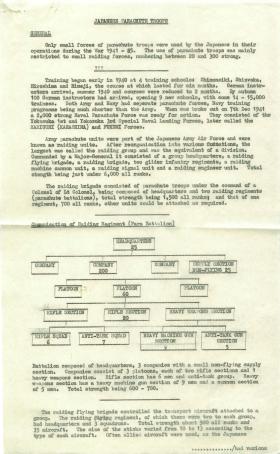Training for Japanese paratroopers began in early 1940 at four training schools at Shimonsiki, Shizvoka, Hiroshima and Himeji. With the arrival of German instructors in the summer, six month courses could be reduced to two. Nine new schools were established with 14,000 to 15,000 trainees. Stringent qualifications were applied as in most airborne forces, the age limit was 20 to 25 for soldiers and up to 28 for officers. Both the Army and Navy had separate parachute forces.
Army parachute units were part of the Japanese Army Air Force and were called Raiding Units. A raiding regiment equated to battalion size and the largest unit was the Group, of division size and commanded by a Major General. Raiding Flying Regiments provided the transport aircraft, which were generally attached to a Group.
Only small forces of parachute troops were employed by Japanese forces during the Second World War. On 11th January 1942 naval parachute troops from the Yokosoka 1st Special Naval Landing Unit captured Menado airfield on the island of Celebes (now Sulawesi) in the Dutch East Indies. Japanese parachute troops captured Palembang airfield in February after a fierce and costly fight, but failed to secure the Dutch oil refineries nearby, which were blown. A further raid of about 350 strong was conducted against Timor.
Raids were generally restricted to small forces numbering from 20 to 300 strong. Like the German experience they were costly and successful at the outset but less so as the war progressed. Parachute operations mounted against Leyte in 1944 were unsuccessful.
Japanese Airborne Forces
Newsletter Signup
Donate
Donate
Make a donation to Airborne Assault ParaData to help preserve the history of The Parachute Regiment and Airborne Forces
The Airborne Shop
The Airborne Shop
The Airborne Shop is the official shop of Support Our Paras (The Parachute Regiment Charity RCN1131977).
Profits from all sales made through our shop go directly to Support Our Paras, so every purchase you make with us will directly benefit The Parachute Regiment and Airborne Forces.







Latest Comments
There are currently no comments for this content.
Add Comment
In order to add comments you must be registered with ParaData.
If you are currently a ParaData member please login.
If you are not currently a ParaData member but wish to get involved please register.